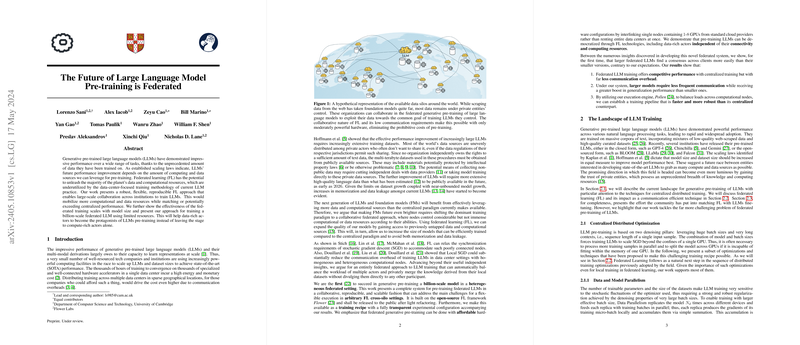The Future of LLM Pre-training is Federated
The paper "The Future of LLM Pre-training is Federated" presents a pivotal shift in the paradigm of training LLMs by leveraging federated learning (FL). The authors propose that the most effective means of improving LLM performance is to move away from the current centralized, compute-intensive model training methodology and adopt a federated, collaborative approach. This shift aims to democratize access to LLM training by harnessing the underutilized data and computational resources distributed globally.
Core Contributions
The principal contributions of the paper are the development of a robust, flexible, and reproducible federated learning framework that can facilitate the training of LLMs on a global scale:
- Federated Learning for LLMs: The authors present a federated approach to training LLMs, enabling collaborative utilization of data and computational resources across various institutions. This method not only matches but potentially exceeds the performance of centralized training methodologies.
- Scalability: The paper documents the successful training of LLMs of up to 1.3 billion parameters using the federated approach. This is the first recorded instance of generative pre-training of a billion-scale model within a heterogeneous federated setting.
- Communication Efficiency: The federated learning strategy significantly reduces communication overhead compared to traditional centralized methods, making it feasible for institutions with limited computing power and less powerful network infrastructures to participate.
- Broad Hardware Inclusivity: The technique accommodates participants with diverse hardware capabilities, ranging from powerful GPUs to standard cloud-based setups with single GPUs.
- Empirical Validation: Extensive experiments validate the model's efficacy and performance, demonstrating that larger federated models reach consensus more easily and efficiently compared to smaller ones.
Methodological Insights
The research explores several key dimensions of federated training:
- Data and Model Parallelism: The federated approach leverages both data and model parallelism to distribute the training load across multiple nodes. This distribution reduces the memory load on individual GPUs and aligns with the scalability goals.
- Local SGD and Gradients: By employing local stochastic gradient descent (SGD), the federated framework mitigates the need for synchronous updates and reduces the communication burden. The results showed that federating the optimization process helps align client models towards a global optimum more effectively.
- Memory and Computation Management: Techniques such as activation checkpointing and CPU offloading are employed to manage the memory and computational requirements of the training process, making it accessible to a wider range of hardware configurations.
Experimental Validation
The authors conducted rigorous experiments using a variant of the C4 dataset, randomly split across eight clients. Key findings include:
- Larger Models Achieve Better Consensus: The research indicates that federated optimization improves convergence and performance as the model size increases. For example, the convergence phase for a 1.3 billion parameter model occurs much more rapidly compared to a smaller 75 million parameter model.
- Performance Comparisons: When comparing the federated approach to centralized training, larger federated models demonstrated performance parity with centralized models, proving the feasibility and effectiveness of federated learning for large-scale LLMs.
Implications and Future Research
The implications of this research are profound:
- Democratization of LLM Training: By enabling entities with significant data but limited computational resources to participate in LLM training, the federated approach democratizes access to high-quality LLMs.
- Privacy-Preserving Data Utilization: FL inherently supports privacy-preserving techniques, making it possible to utilize sensitive data without compromising privacy.
- Scalability and Data Sources: The ability to aggregate diverse data sources can enhance model generalization and reduce biases inherent in models trained on limited data sources.
Future research directions proposed in the paper include further optimizing the federated training framework, scaling up both the population of clients and the size of the models, and exploring the impact of data heterogeneity on model performance. Moreover, fine-tuning the federated models on established benchmark tasks will provide deeper insights into their utility across a broad range of applications.
Conclusion
This paper advances the field of LLM pre-training by introducing and validating a federated learning framework that democratizes access to model training capabilities. This framework leverages the untapped data and computational resources distributed worldwide, proving that a collaborative approach can match and potentially surpass the performance of centralized methodologies. The authors' rigorous empirical validation and thoughtful consideration of future work make a compelling case for federated learning as a sustainable and inclusive path forward in AI development.
